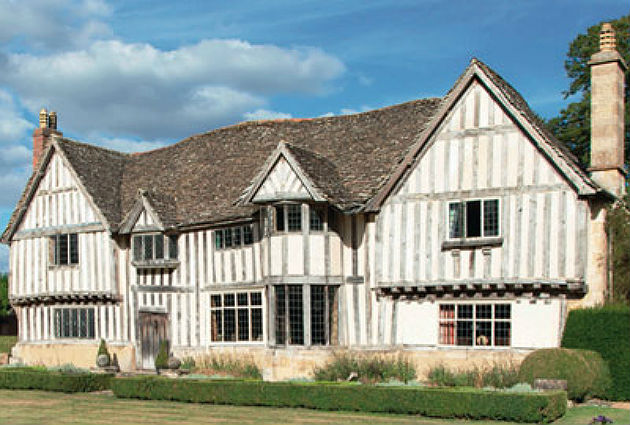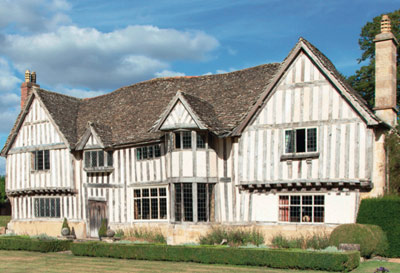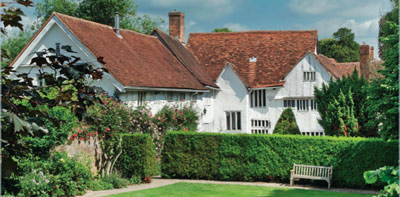Magnificent medieval houses in Oxfordshire and Suffolk
Penny Churchill uncovers properties that aren't just homes-they're pieces of history


The tranquil rural hamlet of Yelford, three miles south of Witney and 13 miles from Oxford city centre, is one of the smallest in Oxfordshire, yet, according to Pevsner, boasts ‘the best and certainly the most picturesque large timber-framed house in the county'. That house is the wonderfully atmospheric, late-15th-century Yelford Manor, listed Grade II*, which is being sold on the open market for the first time in 60 years, through Savills (01865 339700), at a guide price of £2.3 million. In the early 15th century, the manor of Yelford was held by a branch of the landowning Hastings family, whose seat was at Daylesford - then in Worcestershire, but part of Gloucestershire from 1931. In the late 1400s, the present timber-framed manor, partly surrounded by a moat, was built on the site of an earlier house for John Hastings.

Yelford Manor, Savills, £2.3m
The house was substantially altered, in about 1600, when a first floor was inserted in what had been the great hall, and a great stone chimneystack was added: this caused the central part of the house to tilt sideways, and the south wing was later partly rebuilt in stone. The hall and side wings are not linked structurally and were probably added in stages. Some 50 years later, in 1651, Hastings' great-grandson, also John, sold the by-then indebted Yelford estate to William Lenthall, the Speaker of the House of Commons, a kinsman by marriage. For almost three centuries, Yelford remained in the Lenthall family, although the owners lived elsewhere.
In 1949, Edith Lenthall sold the Yelford estate to a local landowner who kept the land, but three years later sold the manor house to Oxford professor Bernard Babington Smith OBE. By then, the manor-used to house estate bailiffs and farm workers in the late 1800s, and sub- divided in the early 1900s to accommodate three families - was more or less derelict. Initially rescued by the Babington Smiths, Yelford Manor has been extensively renovated by its present owner, the medievalist and writer Roger Rosewell who, in 1984, heard that Professor Babington Smith was think- ing of selling, and, with Pevsner's endorsement ringing in his ears, went to see the house, and bought it on a handshake the same day.
A passionate supporter of the SPAB and its principles of ‘conservative repair', Mr Rosewell spent the next 16 years gradually restoring the roof, removing modern partitions to open up the first floor, installing new plumbing and heating systems, and creating an enclosed courtyard with a cloister linking a 19th-century dairy block to the house. A plaque in the courtyard commemorates the bicentenary of the acquittal in 1795 of Warren Hastings, first Governor-General of Bengal, and a descendant of the John Hastings who sold Yelford in 1651.
Mr Rosewell also laid out Yelford's exquisite landscaped gardens, creating a series of dramatic vistas in the lee of the 16th-century church of St Nicholas and St Swithun, which was rebuilt by the Hastings family at around the same time as the house. As well as the moat, the manor's 7.5 acres of grounds include a well-stocked orchard, woodland, two paddocks and some 5,000sq ft of redundant early-19th-century farm buildings.
The house itself has some 5,300sq ft of accommodation, including an impressive drawing room (the original Great Hall), an intimate, part-panelled dining room, a Jacobean panelled sitting room, a music room (the former medieval buttery), six bedrooms and four bathrooms. The stone-built 17th- and 19th-century wing, with its enclosed cloister leading to the courtyard, houses a large kitchen/ breakfast room with a Mark Wilkinson ‘Cook's Kitchen', a study and a library.
Sign up for the Country Life Newsletter
Exquisite houses, the beauty of Nature, and how to get the most from your life, straight to your inbox.
Even after 30 years, the interplay of light and shadow around the manor's ancient walls is a daily source of inspiration for its owner. ‘Not only is the house great fun to live in, but it works really well as a family home. And with systems such as plumbing and heating that work, you don't have to be super-rich to live here. All it takes is a bit of tidying up from time to time', he says airily.

Lavenham Priory, Jackson-Stops & Staff, £1.85m
With its 340 listed buildings, the medieval village of Lavenham, Suffolk is one of the best-preserved in england, thanks in no small measure to the efforts of Henry Taylor and his patron, Princess Louise, who, in 1912, managed to prevent the export of its Wool Hall to America, thereby setting the mark for the conservation of historic buildings in Lavenham and elsewhere.
Currently for sale through the Bury St edmunds office of Jackson-Stops & Staff (01284 700535) at a guide price of £1.85m, is the historic, Grade I-listed Lavenham Priory - a glorious, half-timbered, medieval hall house once part of the Benedictine Priory of earls Colne in essex. Following the dissolution of the monas- teries in 1536, Henry VIII confiscated the priory estates and sold them back to the descendants of their original owners, the de Veres.
Lavenham Priory was owned briefly by edward de Vere, 17th earl of Oxford, before being sold in the 1540s to one of Lavenham's rich clothiers, Roger Ruggles. In the late 16th century, the Priory and its adjoining farmland were bought by Henry Copinger, the rector of Lavenham, and thereafter changed hands on a regular basis as a tenanted farm. The Priory was eventually split into several houses and fell into disrepair, before being elegantly restored by its present owners, who bought it 18 years ago and have since run it as a multi-award winning, five-star B&B.
Set in three acres of grounds, compris- ing formal and kitchen gardens, an orchard, a paddock, a pond and a small copse, Lavenham Priory stands in a com- manding position in the heart of the village. The house, which evolved over several centuries following the fortunes of the wool-trade, has some 7,800sq ft of living space, including the splendid Great Hall, three reception rooms, a kitchen/breakfast room, six letting suites and a self-contained annexe wing.
* Follow Country Life property on Twitter
Country Life is unlike any other magazine: the only glossy weekly on the newsstand and the only magazine that has been guest-edited by HRH The King not once, but twice. It is a celebration of modern rural life and all its diverse joys and pleasures — that was first published in Queen Victoria's Diamond Jubilee year. Our eclectic mixture of witty and informative content — from the most up-to-date property news and commentary and a coveted glimpse inside some of the UK's best houses and gardens, to gardening, the arts and interior design, written by experts in their field — still cannot be found in print or online, anywhere else.
-
 Six rural properties with space, charm and endless views, as seen in Country Life
Six rural properties with space, charm and endless views, as seen in Country LifeWe take a look at some of the best houses to come to the market via Country Life in the past week.
By Toby Keel
-
 Exploring the countryside is essential for our wellbeing, but Right to Roam is going backwards
Exploring the countryside is essential for our wellbeing, but Right to Roam is going backwardsCampaigners in England often point to Scotland as an example of how brilliantly Right to Roam works, but it's not all it's cracked up to be, says Patrick Galbraith.
By Patrick Galbraith